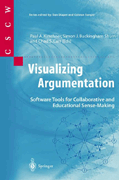Front Cover |
Preface [Full Text] |
Chapter One |
Chapter Two |
Chapter Three |
Chapter Four |
Chapter Five |
Chapter Six |
Chapter Seven |
Chapter Eight |
Chapter Nine |
Afterword |
Index |

Visualizing Argumentation: Software Tools for Collaborative and Educational Sense-Making.
Paul A. Kirschner, Simon J. Buckingham Shum and Chad S. Carr (Eds.)
Springer-Verlag: London
2003
ISBN 1-85233-6641-1
www.VisualizingArgumentation.info
Recommend to a Friend
Purchase Now
Cited References/Websites Boland, R. J. J., & Tenkasi, R. V. (1995). Perspective making and perspective taking in communities of knowing. Organization Science, 6(4), 350-372. Buckingham Shum, S., MacLean, A., Bellotti, V., & Hammond, N. (1997). Graphical argumentation and design cognition. Human-Computer Interaction, 12(3), 267-300. Buckingham Shum, S., Motta, E., & Domingue, J. (2000). ScholOnto: An ontology-based digital library server for research documents and discourse. International Journal on Digital Libraries, 3(3), 237-248. Buckingham Shum, S., Uren, V., Li, G., Domingue, J., Motta, E., & Mancini, C. (2002). Designing representational coherence into an infrastructure for collective Sensemaking. Invited contribution to: National Science Foundation Workshop on Infrastructures for Distributed Communities of Practice, San Diego, CA. Retrieved on August 1, 2002 from http://kmi.open.ac.uk/projects/scholonto/docs/SBS_DCP2002.pdf Chen, H., & Ho, T. K. (2000). Evaluation of decision forests on text categorization. Proc. 7th SPIE Conference on Document Recognition and Retrieval, 191-199. Egghe, L., & Rousseau, R. (1990). Introduction to informetrics: quantitative methods in library, documentation and information science. Amsterdam: Elsevier. Egghe, L., & Rousseau, R. (in press). Co-citation, bibliographic coupling and a characterization of lattice citation networks. Scientometrics. Erdos, P. A. R. (1960). On the evolution of random graphs. Publications of the Mathematical Institute of the Hungarian Academy of Sciences, 5, 17-61. Garfield, E. (1994, October 10). Research fronts. Current Contents. Retrieved on August 1, 2002 from http://www.isinet.com/isi/hot/essays/citationanalysis/11.html Gruber, T. R. (1995). Toward principles for the design of ontologies used for knowledge sharing. International Journal of Human-Computer Studies, 43(5/6), 907-928. Knott, A., & Mellish, C. (1996). A feature-based account of relations signalled by sentence and clause connectives. Language and Speech, 39(2-3), 143-183. Knott, A., & Sanders, T. (1998). The classification of coherence relations and their linguistic markers: An exploration of two languages. Journal of Pragmatics, 30, 135-175. Li, G., Uren, V., Motta, E., Buckingham Shum, S., & Domingue, J. (2002). ClaiMaker: weaving a semantic web of research papers. 1st International Semantic Web Conference, (Sardinia, June 9-12th, 2002). Retrieved on August 1, 2002 from http://kmi.open.ac.uk/projects/scholonto/docs/ClaiMaker-ISWC2002.pdf Mancini, C., & Buckingham Shum, S. (2001). Cognitive coherence relations and hypertext: From cinematic patterns to scholarly discourse. Proc. ACM Hypertext 2001, (Aug. 14-18, Århrus, Denmark), 165-174. New York:. ACM Press Retrieved from http://kmi.open.ac.uk/tr/papers/kmi-tr-110.pdf Newman, S., & Marshall, C. (1991). Pushing Toulmin too far: Learning from an argument representation scheme (Technical Report SSL 92-45). Xerox Palo Alto Research Center. Pajek (2002). Program for Large Network Analysis. Retrieved on August 1, 2002 from http://vlado.fmf.uni-lj.si/pub/networks/pajek/default.htm Reader, W., & Hammond, N. (1994). Computer-Based Tools to Support Learning from Hypertext: Concept Mapping Tools and Beyond. Computers in Education, 22, 99-106. Rittel, H. W. J. , & Webber, M. M. (1984). Planning Problems are Wicked Problems. In N. Cross (Ed.), Developments in Design Methodology (pp. 135-144). Chichester: John Wiley & Sons. (Published earlier as part of “Dilemmas in a general theory of planning”, Policy Sciences, 4, 155-169, 1973). Shipman, F. M., & Marshall, C. C. (1999). Formality Considered Harmful: Experiences, Emerging Themes, and Directions on the Use of Formal Representations in Interactive Systems. Computer Supported Cooperative Work, 8(4), 333-352. Toulmin, S. (1958). The Uses of Argument. Cambridge: Cambridge University Press. Trigg, R., & Weiser, M. (1983). TEXTNET: A Network-Based Approach to Text Handling. ACM Transactions on Office Information Systems, 4(1), (pp 97-100) Watts, D. J. (1999). Small Worlds: The Dynamics of Networks Between Order and Randomness. Princeton, NJ: Princeton University Press. Other Related Resources ClaiMaker web environment for modelling and analysing claims and arguments in any digital library. Back to Top Back to Front Cover |